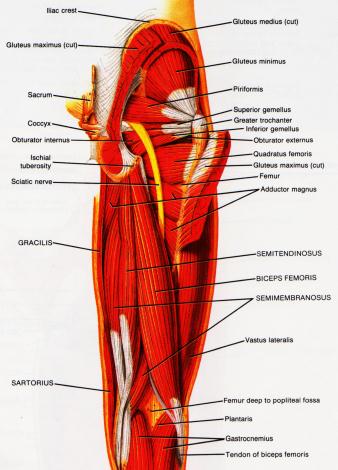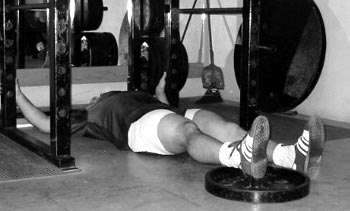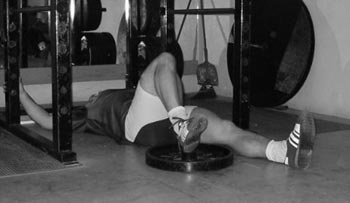Male weightlifters want to be able to lift thousands of pounds off the ground with minimal effort. It makes us feel good to be able to pick up anything we want. Especially when most guys in the world struggle to pick up even 100 lbs off the floor.
Female weightlifters want to sculpt and tone their thighs and buttocks. It makes them feel good to have a tight butt that can fit into size 2 pants. Especially when the majority of American women are roley and poley, thanks in no small part to low fat dieting in the 80′s and 90′s, and to the yo-yo dieting of the new millennium.
The number one way to make all these things happen? Train your hamstrings, lower back, and glutes (your bum) with complex free weight exercises.
As I mentioned in my top 5 quad exercises post, your legs are the largest group of muscles in your body. By training your legs hard, you will be setting yourself up to gain the most progress compared to every other muscle group.
Strong hamstrings will allow you to:
Pick up anything heavy off the floor or ground.
Burn as many calories during training as you would when training quads.
Form the foundation of your body’s posterior strength chain.
Strengthen your lower back to protect from injury.
Anatomy of the Hamstring
Hamstrings sit on the back of the leg and run from the back of the knee up to the butt. They often work in conjunction with the glutes and lower back muscle for picking things up, and for core stability.
These muscles are not that easy to flex or to show, and because they are virtually hidden from view, novice trainers don’t put much emphasis on building the size or strength of their hammies. This is a grave mistake since strong hamstrings, glutes, and lower back are responsible basically for the health and stability of your entire body.
The hamstrings are made up of three main muscles:
Biceps Femoris
Semimembranosus
Semitendinosus
These muscles all share an origin on the pelvic bone, under the glutes, and they attach to the tibia bone on the lower portion of the leg.
Biceps femoris has a short head and a long head. Long head attaches to the hip, while short head attaches as high as the insertion of the glutes.
Semimembranosus lies on the back and medial side of the thigh. It originates higher on the hip than biceps femoris and semitendinosus, and attaches to the medial condyle of the tibia.
Semitendinosus lies on the posterior and medial side of the thigh. It originates on the lower portion of the hip and inserts into the upper portion of the tibia.
Of related interest are the glutes and the muscles of the lower back.
 Hamstring Anatomy |
Functions of the Hamstrings
Hamstrings function to flex the knee and extend the hip. Knee flexion is the act of bringing your heels towards your backside, while hip extension describes a movement wherein your leg extends behind your hips.
Leg curls are an example of knee flexion and stiff leg deadlifts are an example of hip extension.
Glutes assist with extension, lateral rotation, and also abduction. The lower back muscles provide stability for the spine through all bending, lifting, and twisting movements.
Top 5 Best Hamstring Exercises
Of course squats and lunges are part of this list, but I intend to target exercises that train the hamstrings more directly. For more information on squats and other quad dominant leg exercises, see my post about the 5 best exercises for quads.
Barbell Deadlifts
Deadlifts are one of the primary, fundamental exercises for all serious weight training programs. Deadlifts work 100% of your legs and they require functional stability from 95% of the rest of the muscles on your body. Using proper form, deadlifts will help you get stronger, gain more muscle, and burn more calories than any other single exercise after the squat.
To set up: the barbell rests on the floor, sitting just above the ankles right in front of the shins. Your stance should be shoulder width for conventional deadlifts. Bending your knees, reach down and grab the bar so that your knees are actually inside your elbows. When going heavy, it helps to alternate your grip where one hand is pronated (palm facing you) and the other hand is supinated (palm facing away).
To deadlift: to start a deadlift, use your whole body to begin to lift the bar off the floor. Arms should be straight, knees should be bent. The object is to lift the weight with your legs, glutes, and hips, rather than with your lower back. In fact your lower back should not bend that much, should in fact be pretty straight, and should definitely NOT be rounded. You accomplish this by keeping your head up and by driving with your hips. It is of utmost importance to keep the bar close to your body during the lift.
At the top you should stand up straight, but do not over extend your lower back as if you were doing some kind of hyper-extension. The driving force at the top should be more of a hip thrust than a lower back spasm. Lower the bar under control, keeping it close to your body.
Variations: close stance deads, wide stance deads, sumo style deads, deads off a box, rack pulls or pin pulls, deads or rack pulls with chains or bands.
Stiff Leg or Romanian Deadlifts
Stiff leg deads are a compound exercise and one of the best mass building exercises for the hamstrings. Form is especially important to avoid becoming the next victim of lower back injury. Make sure to practice stiff leg deads with lighter weight until you master the form.
Stiff leg deads are a compound exercise and one of the best mass building exercises for the hamstrings. Form is especially important to avoid becoming the next victim of lower back injury. Make sure to practice stiff leg deads with lighter weight until you master the form.
To setup: setup similar to a conventional deadlift except that your feet should be set in a narrower stance and your knees should just barely be bent. Use a pronated grip until you get strong enough that an alternating grip is warranted.
To stiff leg deadlift: Do not use your back! This should be another exercise where you drive with your hips and glutes using a straight back. The hips should move out and back to allow you to descend. Do NOT round your back or ‘bend over’ so to speak. Lower the weight down as far as you can without straining your hamstrings or compromising your spine.
Romanian Deadlifts
The Romanian deadlift is another good compound ham exercise. Again, form is of essence. While similar to the stiff leg deads in the sense that you have to move your hips back during the descent, but the difference is that you can bend the knees a little more through the movement. This often allows one to go lower and lift heavier weight but takes some of the focus directly off the hamstrings. Romanian deads are a bit safer for the lower back.
Good Mornings
Good mornings start like a squat but act like a Romanian deadlift. This is another great exercise for the whole posterior chain.
To setup: the barbell rests on your upper back (traps) and shoulders (deltoids). It should not be sitting on your neck or spine. Bodybuilders tend to place the bar higher, while powerlifters usually hold the bar lower. The powerlifting style is my preference, and I recommend it because it allows you to keep your head and chest higher throughout the exercise, placing less stress on the lower back and neck.
To good morning: keep your head up and your back completely straight. Bend at your waist with your knees locked but slightly bent. Ideally you will bend until your upper body is parallel to the floor, but this is not always possible for novice lifters. Return slowly to the upper position. Work on your form in order to bend over further while keeping your head up and back straight.
Glute Ham Raises
A little known exercise outside of powerlifting circles, the glute ham raise has been gaining popularity in recent years. Like the push up, pull up, and muscle up, this is a bodyweight exercise that really separates the men from the boys; the weak from the strong.
To setup: firstly, you will need to anchor your feet. Find a lip on something, either a machine or a bed or one of those ab benches. Face down, you want to anchor your heels underneath the lip, and if you are not on a pad you will want to place a towel under your knees. Make sure the lip is not sharp or too hard as the pressure against your heels and achillies tendon will be great.
To glute ham raise: starting with your feet anchored and your knees bent at 90 degrees, kneeling on the floor, slowly lower your upper body to the floor. You will probably need to catch yourself at the bottom, at least in the beginning, so you don’t smash your nose. Chances are you will also need to give yourself a slight push off the floor in order to get moving up again. This is a hard exercise and few people are good at it. Anyway, use your hamstrings to pull yourself back up to a kneeling position.
Standing 1 Leg Curls
Basically you take the lying leg curl, stand it up, and do it with one leg. The second best option is a lying 1 leg curl, since most gyms don’t have the standing leg curl machine. If you don’t have either of those machines, you could always resort to plate dragging.To setup and curl: climb on the machine and do a leg curl with one leg, then switch. That’s about all there is to it. This is especially an effective exercise for bodybuilders, but powerlifters and other athletes can do it too.
Plate Drags
To setup: Hold on to something stable while lying on the floor. Extend your legs fully, placing the heel in the hole of a weight plate. Start off with lower weight and work up.
To plate drag: Slide the plate towards you by contracting the hamstring muscles of the working leg. The opposite leg stays extended. This should effectively mimic a leg curl, except that there is no negative or eccentric portion of the movement, which is actually good news because that means less micro-trauma and therefore less DOMS pain.
 |
 |
Honorable mentions:
sled dragging, truck pulling, truck pushing, tire flips, sprints, one leg back extensions, and reverse hypers.
To use the exercise list optimally, you will want to choose 1-3 of these exercises to work into each workout. For full body workouts, choose only one exercise each day. In a 3 day split you would choose one conventional deadlift, one stiff leg or good morning, or one leg curl or glute ham raise for each day of that split.
If you use the outdated method of splitting up your body parts each day, choose 1 deadlift and either a glute ham raise or a leg curl for leg day. You will also have 1-2 quad dominant exercises to complete the leg day, so we can’t focus 100% of our efforts strictly on hamstrings.
Yoga or Gym?
ReplyDeletewhch vl be more beneficial?
it basically depends on the individual.....b4 postng any advice i would rather knw wat age range are you in
Deletei'm a 40 old yr woman.i tried a lot but could'nt reduce my weight.as m a housewife so dnt have enough time 4 gyming.any other suggetions?
ReplyDeletei guess u can install some cardio machines which u could use in liesure time......
Deleteu can also prefer going for yoga....
i hope these things can help